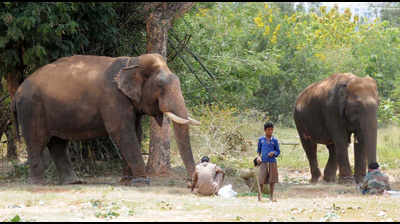- News
- City News
- dehradun News
- Track electrification at Rajaji raises elephant safety fears
Trending
This story is from October 20, 2016
Track electrification at Rajaji raises elephant safety fears
The trial of electrification of Dehradun-Haridwar railway track which also passes through Motichur range of Rajaji tiger reserve was started from Thursday

The trial of electrification of Dehradun-Haridwar railway track which also passes through Motichur range of Rajaji tiger reserve was started from Thursday
DEHRADUN: The trial of electrification of Dehradun-Haridwar railway track which also passes through Motichur range of Rajaji tiger reserve was started from Thursday. The high speed of the trains which will pass through this stretch has also raised concerns for the safety of wild animals as just a few days ago, a young tusker was trampled by a speeding train in Rajaji and another at Ramnagar.
However Railways seems to have swung into defensive mode with the employees’ union and officials not ready to own up to any responsibility in the future for the death of any wild animals by speeding trains. They have also registered their contempt over the forest department filing a case against the train driver for the Rajaji incident.
Principal chief conservator of forests (wildlife) DVS Khati said, “The Railways can go ahead with the electrification of the track in Rajaji tiger reserve only if they meet guidelines on speed and other safety measures, to which they have already agreed in front of the National Wildlife Board before seeking their approval for electrification. If they fail to do so, they will have to face the implications.”
Better coordination, patrolling and also low train speed have been the reasons behind zero mortality of elephants for ten years on the stretch from 2002-2012, while 20 elephants had died here from 1987 to 2001. However, in 2013 too, one elephant had died here.
He also pointed out that the trains too might be derailed or damaged if carcasses of animals hit by other trains continue to be on the track animals trampled upon by the train remains stuck up in the track and damage the train. “So Railways staff must also exercise caution on the tracks in forest areas. Better coordination is required between both sides. Forest staff on patrol can inform the Railways about presence of wild animals on the track at specific points so that the train can be halted at a distance before the forest team drives the animals away to safety.”
State forest minister Dinesh Aggarwal was of the view that the patrolling units must be equipped with firecrackers and other methods to drive elephants away from the track. “Patrolling must also be increased so that no wild animals are hurt or killed by speeding trains,” he added.
However Railways seems to have swung into defensive mode with the employees’ union and officials not ready to own up to any responsibility in the future for the death of any wild animals by speeding trains. They have also registered their contempt over the forest department filing a case against the train driver for the Rajaji incident.
Principal chief conservator of forests (wildlife) DVS Khati said, “The Railways can go ahead with the electrification of the track in Rajaji tiger reserve only if they meet guidelines on speed and other safety measures, to which they have already agreed in front of the National Wildlife Board before seeking their approval for electrification. If they fail to do so, they will have to face the implications.”
Better coordination, patrolling and also low train speed have been the reasons behind zero mortality of elephants for ten years on the stretch from 2002-2012, while 20 elephants had died here from 1987 to 2001. However, in 2013 too, one elephant had died here.
AK Singh, senior official of World Wildlife Fund told TOI, “It has been proven that with the right measures which both the railways and wildlife department had been following at Rajaji, we can ensure zero mortality for wild animals, including elephants. The drivers must lower their speed at turns and at critical points on the track, because the safety of natural resources such as wild animals is not only the responsibility of the forest or wildlife department but of everybody.”
He also pointed out that the trains too might be derailed or damaged if carcasses of animals hit by other trains continue to be on the track animals trampled upon by the train remains stuck up in the track and damage the train. “So Railways staff must also exercise caution on the tracks in forest areas. Better coordination is required between both sides. Forest staff on patrol can inform the Railways about presence of wild animals on the track at specific points so that the train can be halted at a distance before the forest team drives the animals away to safety.”
State forest minister Dinesh Aggarwal was of the view that the patrolling units must be equipped with firecrackers and other methods to drive elephants away from the track. “Patrolling must also be increased so that no wild animals are hurt or killed by speeding trains,” he added.
End of Article
FOLLOW US ON SOCIAL MEDIA










